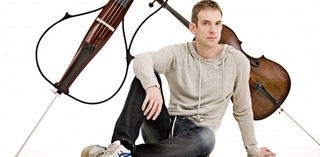|
Back
Taming the Fire Houston
Jones Hall
04/10/2014 - & April 12, 13, 2014
Peter Ilyich Tchaikovsky: Romeo and Juliet – Pezzo capriccioso, Op. 62 – Variations on a Rococo Theme, Op. 33
Sergei Prokofiev: Symphony No. 3 in C Minor, Op. 44
Johannes Moser (cello)
Houston Symphony, Hans Graf (conductor) 
J. Moser (© IMG)
Hans Graf always excelled in Russian repertoire, and, in his return to the Jones Hall stage as Conductor Laureate, he guided his former orchestra through a wonderful juxtaposition of Tchaikovsky and Prokofiev works that allowed each composer to be heard from a fresh perspective.
The placid Harmoniemusik that opens Tchaikovsky's Romeo and Juliet was nuanced and led to a thrilling reading of the main body of the work. With rhythmic exactitude, the dueling Montagues and Capulets were easy to envision, the precision of the rapid-fire cymbal crashes and bass drum thuds punctuating their strife. The first appearance of the love theme was held in check by Graf, but its impassioned return was given lush treatment.
Cellist Johannes Moser joined the orchestra for Tchaikovsky's two concertante works. The contrasts inherent in the Pezzo capriccioso were impressively dashed off by the soloist, who seemed to want to push forward a bit more than Graf would allow. The two were more like-minded in the Rococo Variations, where Moser challenged the orchestra to play impossibly soft, all the while maintaining a beautiful sound. The Variations are an odd but captivating piece, with harmonic surprises that likely delighted the young Prokofiev. The audience was rightly enthralled by Moser's playing and seemed eager for an encore, but Moser didn't oblige, letting his excellence in the programmed works speak for itself.
After intermission, Prokofiev's underrated Third Symphony received a blistering performance that noticeably upended the congeniality of the first half of the concert. Here was the Prokofiev of the Scythian Suite and Second Piano Concerto now residing in the four-movement symphonic mold, dressing driving ostinatos and disjunct melodies in snarling brass passages and slithering string glissandos. As a reconfiguration of The Fiery Angel, the piece makes more sense as a four-scene opera without words than as a "symphony," despite its superficial resemblance to symphonic structure. Each movement is moody, and the middle two demand continuity despite being separated from their surroundings by silence. The orchestration is dense and rhythmically complex, and the teleology of the whole thing is not readily apparent.
These issues could all result in a mess of a performance, but Graf and the orchestra conquered them all with thrilling playing and confidence, allowing each of Prokofiev's machinations to run its course. On the podium, Graf was cool and exacting even when coaxing the most vicious maelstrom from his players, presiding over the most complicated passages with wizened confidence. The result was shattering, conveying a piece of monumental importance that shows a different, important side of this composer.
Marcus Karl Maroney
|